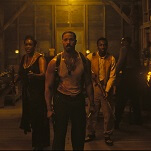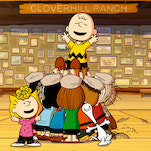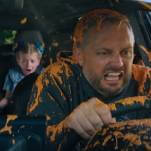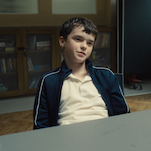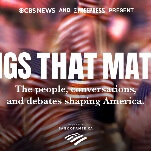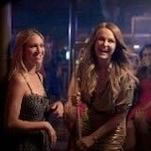Even the funny Death Wish films are repugnantly fascist
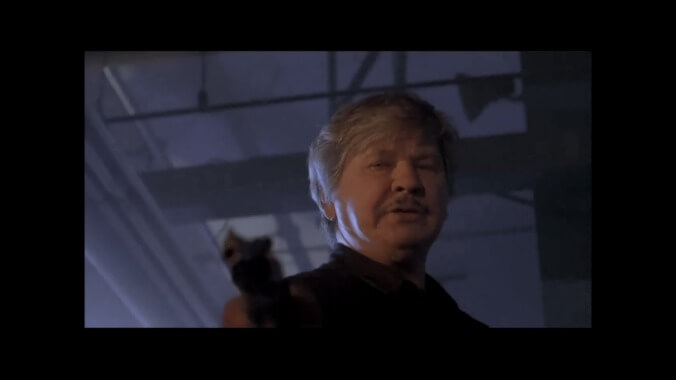
With Run The Series, The A.V. Club examines film franchises, studying how they change and evolve with each new installment.
“I’m not a Charles Bronson fan,” Charles Bronson told his Los Angeles Times interviewer Wayne Warga in 1975. “I don’t think I turned out the way I thought I would turn out when I was a kid. It’s a disappointment. I’m a disappointment to me. My image, my sound, everything else.” A little over two decades into his acting career, Bronson had firmly established his persona as a “hard man” and was widely considered one of the highest-paid (if not the highest-paid) stars of his era. One has to wonder to what extent Bronson’s candid distaste for himself, professional success aside, was an extension of the vile qualities of Death Wish, a film he defended but didn’t seem wild about. The franchise spanned two decades and three directors, from the 1974 original to 1994’s Death Wish V: The Face Of Death, by which point Bronson was 72 and scarcely credible as a remorseless angel of death. (In its review, Variety observed that he looked “mighty tired.”) With variations on who the exact target is, all installments share the same premise: Someone near and dear to architect Paul Kersey (Bronson) has been killed or sexually violated, forcing him to enact fatal retribution.
In 1974, Death Wish fit snugly into a wave of films depicting New York City (specifically Manhattan) at best wildly unpleasant and at worst an apocalyptic wasteland punctuated by random acts of potentially homicidal violence. Escalating from the comparatively anodyne garbage-strike, dysfunctional nightmare of 1970’s The Out-Of-Towners to the heroin junkies appropriating public squares in 1971’s Panic In Needle Park and the corrupt cops of 1973’s Serpico, there was nothing good to say for a city near bankruptcy. The year after Death Wish, New York prompted an infamous headline message from the president: “Ford to city: Drop dead.”
It’d be productive to pair summer 1974’s Death Wish on a double bill with that fall’s The Taking Of Pelham 123. Both rely heavily on the idea of the hellishness of the subway, a normative given. In Pelham, a subway car is hijacked and held ransom (none of the passengers even look up when the car stops mid-tunnel for no apparent reason, so used are they to routine transportation disruptions). In Death Wish, Kersey— angered by his wife’s murder and daughter’s rape by giggling goons—takes to the train at night, sitting with a newspaper and waiting for potential muggers. When they appear (and they always do), he shoots them point blank. Both films have implausibly graffiti-free subway cars, because the MTA thought graffiti was a mere passing trend and didn’t want to encourage it. Violent crime was evidently here to stay.
Wildly successful upon release, Death Wish was the culmination of a string of films in which Bronson honed his silent-and-deadly persona. Several of these—Chato’s Land, The Mechanic, The Stone Killer—were directed by Death Wish helmer Michael Winner, who was routinely referred to as one of the world’s worst directors for his combination of technical slumming and occasionally repugnant material. (He eventually retired from filmmaking and became a restaurant critic, writing a column called “Winner’s Dinners.”) However his Tory politics might have informed his output, it’s not clear that Winner had any real convictions about urban violence, vigilantism, or sexual assault; his work appears simply opportunistic. Whatever its demerits technically and morally, Death Wish is at least clear about its aims and gives the audience exactly what they came to see: a right-wing fantasy (for lack of a more nuanced political characterization) about standing your ground.
The opening makes it clear that living in a big city is itself a kind of death wish. We first see Kersey and his wife on vacation in Hawaii to the backdrop of ukuleles and tropical sounds; they return to Herbie Hancock’s harsh electronic chords and the title superimposed on a blood-red sun. There are two ways to navigate such a routinely violent landscape: You either shrink into your routine while trying to avoid trouble, or you actively “fight back.” Bronson forthrightly cops to a co-worker’s description of himself as a “bleeding-heart liberal,” responding, “My heart bleeds a little for the disadvantaged.” His interlocutor doesn’t bat an eye, declaring that all these criminal should be sent to “concentration camps,” and it’s the movie’s unsavory task to align Bronson and audiences with this unabashedly fascist point of view.
Author Brian Garfield was appalled to find out that his source novel—intended to portray the unraveling psyche of a man shaken by his loved ones’ violation—had been turned into a straight-up pro-vigilante tract. Kersey vomits after his first shooting, but from there on kills without mercy, always choosing his targets wisely. The press takes notice, with a Newsweek billboard wondering “Vigilantism! Can it stop urban crime?” and favorable coverage from New York magazine, Harper’s, and the Chicago Tribune. There are some token white muggers (notably, a young Jeff Goldblum), but the face of urban violence is more likely to be, say, an uncredited Denzel Washington. The movie disclaims any racism or pandering to those who want to enact violence against people of color: At a party, the complaint that those killed are disproportionately black draws an apparently unarguable sarcastic retort as to whether “racial equality among muggers” would be preferable.
The one-man entrapment/killing spree inspires Kersey’s fellow citizens, including a feisty black lady with a hatpin who fends off an attacker and a smirking crew of construction workers who say they “took care” of an assailant. Their presence is an unsubtle wink to the demographic behind 1970’s hard-hat riot, in which some 200 construction workers took on a thousand anti-Vietnam protestors four days after the Kent State shootings. Death Wish’s vision of rough urban justice (levied against both minorities and the suspiciously non-conformist clad) is reminiscent of 1970’s Joe, in which a businessman whose daughter has run off with dirty hippies forms an economically unlikely friendship with a blue-collar grunt. They share a murderous distaste for the counterculture and the general collapse of “moral values,” mingled with a barely concealed sexual interest in presumably loose young women. Joe was intended as social critique, but Death Wish merges both of these impulses by making sure viewers get a good long look at the exposed breasts of women being sexually assaulted, allowing a dose of T&A while asking you to deplore the actions enabling the view. Like its simultaneous disclaimers of racism and barely dog-whistle displays of same (it’s very much the film equivalent of “I’m not racist, but…”), it’s an untenable, plainly opportunistic combination. Audiences didn’t care; fed up with rough city living, they cheered Bronson on.
Eight years passed before the character’s resurrection at the hands of ever-opportunistic Cannon Films mavens Menahem Golan and Yoram Globus, for whom quick, dirty, and cheap exploitation came naturally. This time Kersey is in Los Angeles (the franchise ping-pongs between the two coasts in every installment) and trying to avoid killing people. Nonetheless, he keeps right-wing radio on (“I can’t handle this,” his cleaning lady apologizes, and turns it off), and there’s little doubt that he’s about to pop off again. His daughter Carol (a different actress from the first installment; this movie can barely be bothered to care about its sacrificial lamb) is just starting to recover from her rape, and she smiles with overacted childlike glee when dad takes her to the park and buys her an ice cream. A rape scene ever more unpleasant than the first film’s culminates with her jumping out a window to her death (impaled on the fence below, no less).

